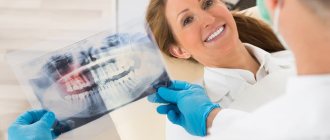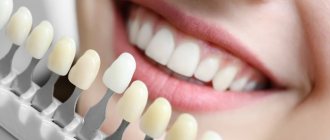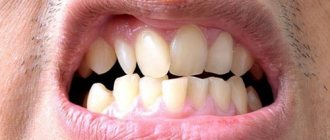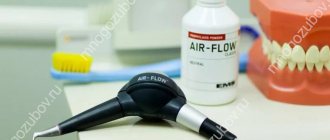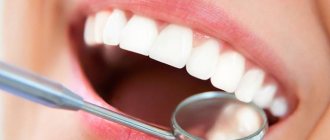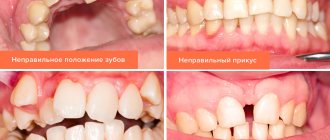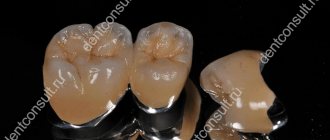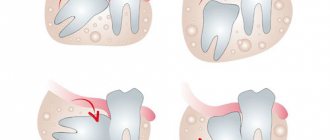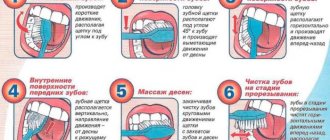British scientists claim that 8 out of 10 people have crooked teeth. At first glance, slight crooked teeth are not such a global problem. Indeed, most people don't even think about why their teeth become crooked and simply ignore this dental problem. But in fact, crooked front (lower or upper) teeth can not only cause psychological discomfort, but also cause serious health problems.
Why do teeth become crooked?
It is quite difficult to figure out why teeth are crooked, since there are many reasons for this anomaly. But there are factors that help explain why teeth grow crooked:
- Personality characteristics: narrow jaw and large teeth that simply do not have enough space in the mouth to grow straight.
- Bad habits: thumb sucking or using a pacifier for too long in children, lip biting, pencil chewing. All these habits lead to the fact that the teeth do not close completely, and the upper or lower jaw lengthens.
- Refusal to treat baby teeth. Unfortunately, there are still dentists who claim that caries in baby teeth does not need to be treated and simply remove the child’s diseased tooth. This cannot be done, since early removal of a baby tooth will lead to displacement and curvature of the entire dentition.
- Mouth breathing: If a person breathes only through the mouth, the shape of the palate gradually changes, which can also cause crooked teeth.
But most of the factors associated with crooked front or any other teeth are laid down in childhood, even in the womb. During the formation of the fetus, dental anomalies of one of the parents can be transmitted to the baby. But even if a child does not have a genetic predisposition, crooked teeth may still appear.
The reasons will be explained by orthopedic dentist of the 32Dent clinic Lyudmila Vladimirovna Ponomareva: “Most dental problems begin in childhood. This also applies to the causes of crooked teeth. If a baby is fed from a nipple with a hole that is too large, he will not make any effort to suck and jaw growth will not be stimulated. This also applies to nutrition: a child’s diet should contain a certain amount of hard food. Thanks to this, baby teeth wear down evenly and jaw growth is stimulated.”
But even if you know exactly why your teeth are crooked, it doesn’t change anything. Unfortunately, there are few qualified dentists who can eliminate malocclusion, and correcting crooked teeth in adults and adolescents is a rather lengthy process.
Genetic predisposition
Many problems with bite and teeth in general are inherited from parents. This factor cannot be influenced. But if you know about it, you can take it into account and plan treatment in time.
If parents have had or have problems with bite, the child should be taken to an orthodontist at the age of 2–2.5 years, when all the baby teeth grow in. As the primary occlusion develops, future problems may be noticed.
Dental health is partly determined genetically
Types and degrees of curvature
The method of restoring crooked teeth depends on the degree of curvature and the age of the patient. On the Internet you can find many photos of celebrities with crooked teeth before and after restoration. How does the correction process work?
First, let's look at the degrees of curvature:
- First degree: refers to individual teeth that differ from the rest in shape, size or location.
- Crooked teeth 2 degrees: incorrectly formed dentition due to the simultaneous eruption of several teeth at once.
- Third degree: curvature at the level of the jaws, which leads to improper closure of the upper and lower dentition.
In addition, the front teeth, incisors or wisdom teeth may be crooked. The front ones, as a rule, change shape or location due to external factors: injuries, the habit of chewing a pen or seeds.
Orthodontist Anastasia Sergeevna Arkhangelskaya from the 32 Dent clinic explains why teeth grow crooked in adults: “In adulthood, people often have to have their teeth removed. If an implant or other prosthesis is not installed in their place, the dentition may become crooked. In addition, the development of dental anomalies is facilitated by the eruption of wisdom teeth. This is especially true for people with a narrow jaw, which simply does not have enough space for large wisdom teeth.”
If you have a problem similar to that described in this article, be sure to contact our specialists. Don't diagnose yourself!
Why you should call us now:
- We will answer all your questions in 3 minutes
- Free consultation
- The average work experience of doctors is 12 years
- Convenient location of clinics
Single contact phone number: +7
Make an appointment
Consequences
Uneven teeth predispose to the development of caries.
This occurs due to the difficulty of hygienic cleaning. There is also an increased predisposition to tonsillitis, gum disease, and dysfunction of the temporomandibular joint. Excessive crowding or, conversely, the presence of interdental spaces contributes to impaired diction. The person begins to burr and lisp. In some cases, such pathology is a contraindication to prosthetics.
Uneven lower or front teeth will not straighten out on their own. To eliminate the problem, the help of an orthodontist is necessary.
How to straighten crooked teeth?
The selection of a means for straightening crooked teeth is carried out according to the type of anomaly and taking into account the patient’s age.
To correct malocclusion in children, removable plates or trainers are used. They perform several functions:
- align the position of teeth and jaws;
- normalize muscle function;
- relieve excess pressure from the jaws that the tongue and cheeks exert during conversation or eating.
The use of removable corrective devices is effective only up to 10-12 years. After this, the child develops a permanent bite, which can only be corrected with special mouth guards or braces.
Modern dentistry provides a huge selection of braces. Most often they are installed on the outer surface of the teeth. Unfortunately, they are noticeable during conversation and spoil the aesthetic appearance of a smile. If the aesthetic factor plays a key role, you can install special lingual braces. They are placed on the inside, so the adjustment occurs almost unnoticed by others.
Material used for work
Prostheses are made from stainless steel, dental ceramics, plastic and a combination of the above materials.
- Steel
The most common material is stainless steel due to its strength, manufacturability and low price. For prosthetics, a socket is used, which is stamped at a factory or in a clinical laboratory. The top of the workpiece is coated with ceramics, plastic, or titanium nitride is sprayed for a “gold-like” coloring.
- Metal alloys
Alloys of gold, silver, cobalt, and titanium are used to make prostheses. Such crowns do not cause allergies, are resistant to oral fluid, and have a long service life. Disadvantage: low aesthetics.
- Metal ceramics
Their base is metal, resistant to cracking. Ceramic mass is applied on top, which can be given an aesthetic appearance.
- Ceramics
This material is closest in color to tooth enamel. Dental ceramics are highly durable and can withstand heavy chewing loads.
- Metal-plastic
Plastic crowns are fragile and are used temporarily until permanent structures are made. Metal-plastic dentures have a base made of metal and an applied plastic coating, which looks aesthetically pleasing. With careful use, these crowns will last for several years.
Stages of crown installation
You will have to visit the dentist's office several times when getting dentures. It is necessary to examine the teeth, take x-rays of problematic units, sharpen them, and select materials. An impression is taken from the tooth, from which a crown will be made in the laboratory. It is bleached, sanded, and only then installed.
Care Tips
Crowns do not require special care. It is necessary to brush your teeth 2 times a day. It is better to use flosses, rinses, brushes. It is not recommended to chew hard foods. It is advisable to quit smoking.
Alternative methods
| Click to sign up for a FREE consultation |
The bite can be corrected in other ways, for example, by doing exercises, installing mouth guards, fixed orthodontic devices, or undergoing surgery.
During gymnastics, dysfunction of the muscles of the face and jaw is put in order. This is what often leads to malocclusion.
Orthodontic structures (braces) use metal arches to act on abnormally located teeth. Disadvantage: long wearing time, high price.
Mouth guards are removable polymer pads that cannot be worn all the time. Operations to correct the bite are carried out in difficult cases when other methods do not help.
A good bite ensures proper chewing of food, good speech and a beautiful smile. Due to improperly positioned teeth, complications can develop, including severe migraines and ear diseases.
Overview of correction methods
Each method of correcting crooked teeth has its own characteristics. To figure out how to correct very crooked teeth, consider all the means that are used for this:
- Braces. These are small plates made of ceramic or metal that are attached to each individual tooth and connected to each other with a special arch. The plates apply uniform pressure on the teeth, gradually leveling their position. Most models of braces are installed on the front part of the teeth, so the plates are visible when speaking. But there are also special, lingual braces. They are placed on the inside of the teeth. This design is more expensive, but it does not spoil the smile at all.
- Mouthguards. These are removable plastic structures that the patient can remove and install himself. It is important that the more often the trays are used, the faster a positive result will be achieved. Typically, mouthguards are used to correct crooked front teeth. The mouth guards themselves are used to correct the bite in children, and they are often placed on adults only to consolidate the achieved result.
- Trainers. Removable devices that are worn at night. They are used only to correct minor malocclusions and crooked teeth.
- Plates. Made from plastic or metal. They are attached to teeth or crowns with special hooks. Most often used to correct bite in children with small defects.
Veneers. In fact, these are onlays that do not eliminate a tooth defect, but only hide it. Therefore, the question of whether veneers will correct crooked teeth can have only one answer: it is physically impossible if the entire dentition is deformed. But in fact, installing veneers on crooked teeth will help if their surface is uneven. In this case, veneers will simply hide the desired areas- Lumineers. Their installation also allows you to correct minor defects. In fact, lumineers are similar to veneers: they are also glued to the surface of the tooth to level it. But lumineers are thinner than veneers, although this does not affect their strength.
- Restoration and prosthetics of crooked teeth. This is a special type of treatment in which each tooth is straightened individually with crowns or composite material. Under the light of a special lamp, it quickly hardens and is completely indistinguishable from an ordinary tooth. The only disadvantage of composite restorations for crooked teeth is that the material can be stained with food coloring.
Sometimes even braces or veneers are not enough to straighten crooked teeth. A crooked tooth can be corrected with a crown, but if the dentition is deformed due to the eruption of a wisdom tooth or anatomical abnormalities of the jaw, surgical intervention may be required. For example, straightening the dentition in some patients can only be done by removing a wisdom tooth, which puts pressure on neighboring teeth and moves them.
Indications for installing crowns for crooked teeth
If a patient is diagnosed with the first stage of bite deformation, when the defect involves 1-2 elements, then it is quite possible to solve the problem with the help of crowns. Their installation is indicated when the following anomalies are present:
- the tooth is rotated around its axis, tilted, has an irregular shape or a shortened/elongated crown part: you can align, or, more precisely, correct such teeth with crowns and make sure that they do not stand out from the rest,
- trema and diastema: designs will help fill excess space, reduce unaesthetic gaps,
- hard tissues are severely damaged as a result of caries, injury, or there is a chip: in this case, the product will help strengthen hard tissues, protect them from the effects of negative factors, from premature destruction or removal,
- slight crowding: for example, when the two front teeth overlap each other slightly.
The doctor may also recommend the installation of dentures before orthodontic treatment or at the final stage of bite correction using braces, aligners or trainers.
How much does it cost to fix crooked teeth?
If you want to know what to do about crooked teeth, the first step is to consult a qualified orthodontist. He will determine which method is best to use and install a corrective system.
Modern dentistry offers a wide range of systems for correcting crooked teeth and malocclusion. They all vary in cost. It is important to choose not only a correction method that is suitable for the price, but also to contact qualified specialists.
There are not so many orthodontists with the required qualifications (as well as dentists of other specializations), but at the 32 Dent clinic there are specialists who install braces, veneers and other bite correction systems for adults and children. It’s also nice that the clinic has fairly affordable prices, so almost all patients can correct their crooked teeth.
Insufficient attention (from parents) during the period of occlusion change
Sometimes baby teeth fall out, on the contrary, too late. The permanent ones are already erupting, but the milk ones are still preserved. Parents bring their child to the doctor with the words: “My child’s teeth are erupting in two rows.” In such a situation, the permanent tooth erupts in the wrong position.
These little “sharks” sometimes come to the doctor
Moreover, you can immediately remove the delayed milk teeth, but the position of the permanent teeth will not improve on its own.
Teeth straightening – the price of the issue
Methods for straightening crooked teeth have been described above. Now let's take a closer look at the cost of each of them:
- Installation of braces. The cost depends on the type of system used. For example, the price of sapphire braces starts from 20 thousand rubles. Metal systems are cheaper (about 10 thousand rubles), and the most modern, invisible lingual braces will cost 50 thousand.
- Correcting small bite defects with mouth guards costs from 50 thousand rubles per jaw.
- An initial course of bite correction with a trainer from a qualified specialist will cost 15 thousand rubles. The advantage of this treatment method is that it is absolutely painless, does not harm the teeth and can be used to correct the bite even in young children.
- Veneers and lumineers. The cost of restoring teeth using these plates depends on many factors. First of all, the price varies depending on the material and the manufacturing company. In addition, the final cost depends on the number of teeth being corrected. On average, the price of one veneer ranges from 10 to 12 thousand rubles including installation.
- The cost of dental restoration is determined individually, depending on the materials used and the location of the teeth. For example, the price of composite restoration of crooked front teeth starts from 7 thousand rubles. It is cheaper to restore side teeth: from five thousand.
If you plan to install crowns, the price will depend on the material used. In addition, additional costs may arise during treatment for adjustments to alignment systems.
